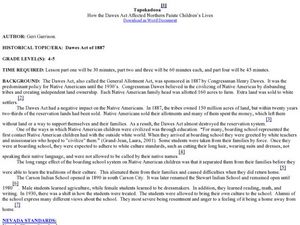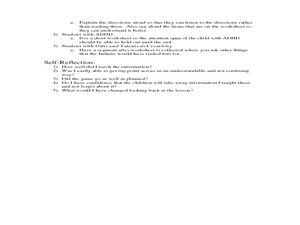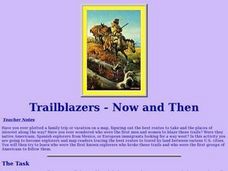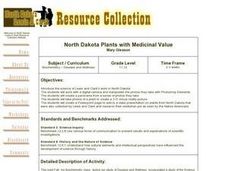Curated OER
San Luis Trip
Second graders get an authentic field trip view of an archeological site replicating the influences of the Apalachee Indians and Spanish missionaries. The following day, 2nd graders share their journals at team tables.
Curated OER
Evaluating Information Quality: Identifying Useful Information
Third graders examine different types of information and evaluate its accuracy. In groups, they research tribal heroes from the present and past. As a class, they identify what they need to look for to determine if the information is...
Curated OER
An Encounter of Former Foes
Students examine a timeline on the internet showing the relationship between the American Government and the Nez Perce in the 19th Century. After looking at the timeline and included map, students answer questions.
Curated OER
I Heard the Owl Call My Name
Eleventh graders write a two to three page paper addressing one of the following topics: Analyze the values and beliefs of the two conflicting cultures. Explain which values seem to dominate within the conflict and why. They brainstorm...
Curated OER
The Industrial Revolution
Eighth graders examine the time period of the Industrial revolution in American history. In this American History lesson, 8th graders read the chapter on this time period. Students create a presentation on this time period to...
Curated OER
Centennial: This I Value...Hidden Treasures
Fourth graders explain the contributions of Native American Indians, explorers, and Utah's pioneers. They classify items based on value and determine what makes them valuable to individuals, groups, communities, etc.
Curated OER
Education and Self Determination
Students read and discuss a section from Encyclopedia of North American Indians. They select and locate various sources to red/listen to and take notes on.
Curated OER
Mapping the 'Utah War'
Eleventh graders examine the contributions of Native American Indians, explorers, and Utah's pioneers.
Curated OER
Can't You Make Them Behave, King George?
Fifth graders describe the changes in King George III's policy toward the American colonies by sequencing key events between the French and Indian War and the American Revolution. They explain the colonial reactions to command decisions...
Curated OER
Consequences of Individual Choices
Students take the sides of Patriots or Tories. In this colonial American lesson plan, students read primary sources that feature James Murray and Captain Jones. Students then write dialogues and limericks based on a fictional meeting of...
Curated OER
The Four Corners Region of the United States Cultures, Ruins and Landmarks
Students who live in the inner city are introduced to the four corners region of the United States. In groups, they examine how the region differs compared to where they live and their culture. They develop maps of the area and locate...
Curated OER
The Trail of Tears; Its Grief and Loss
Fifth graders trace the development and expansion of the US while studying the Trail of Tears. They examine the political factors and analyze the impact the Indian Removal Act had upon a society. They present a case for or against the...
Curated OER
Property, Theft and Generosity
Students examine excerpts of Lewis and Clark's journal entries during their expedition. They identify any disputes with the Indians over land and discuss how they might have been avoided. They add entries to their journals.
Curated OER
Taking Up Arms and the Challenge of Slavery in the Revolutionary Era
Students examine a series of documents which discuss the contradiction in the Americans' rhetoric about slavery. They act as members of designated Committees of Correspondence in the five different colonies, communicating their...
Curated OER
Tapokadooa: How the Dawes Act Affected Northern Paiute Children's Lives
Learners investigate the Dawes Act and understand its effects on the Paiute Indians. In this Paiute lesson, students recognize that many Native Americans lost their land and money after the Dawes Act. Learners dissect a worksheet for...
Curated OER
Whose Buffalo?
Seventh graders examine how the Plains Indians vied with white commercial buffalo hunters for the millions of Great Plains buffalo. They create an illustrated broadside supporting the interests of either the Indians or the commercial...
Curated OER
History And Tradition of Seminole Patchwork And Clothing
Students interview Seminole patchwork makers to find out about the history behind patchwork, how patchwork is made, and the meanings of various Seminole patchwork. Then they create some patchwork of their own.
Curated OER
Cornplanter and the Fate of His Land
Young scholars explore Chief Cornplanter and his importance as the leader of the Seneca tribe. In this Chief Cornplanter lesson, students examine how the Seneca land was taken over by the right of eminent domain. Young...
Curated OER
Aboriginal Statistics
Fourth graders analyze statistics of Native Americans by creating graphs. In this data analysis lesson plan, 4th graders define different statistical terms and practice finding those statistics from groups of numerical information...
Curated OER
La Salle and the Fur Trade
Fourth graders examine the fur trade of the 1700's. In this explorers instructional activity, 4th graders discuss how the French explorers traded items with the Native Americans for fur. They look at the explorer La Salle and how he...
Curated OER
Inference By Analogy
Students infer the use or meaning of items recovered from a North Carolina Native American site based on 17th-century European settlers' accounts and illustration.
Curated OER
Trailblazers- Now and Then
Young scholars examine and study the routes of trailblazers. In this American history lesson, students find a route on a map and compare that to the route of trailblazers. Young scholars will then compare that map with a topographical...
Curated OER
North Dakota Plants with Medicinal Value
Students use the internet and plant guides and other resources to identify plants and their medicinal importance as seen by the Native Americans. They view a copy of the Lewis and Clark journal that held photos of the plants of their...
Curated OER
CAPITALIZATION
Learners write a class A,B,C book based on people and events important to the class. They use capital letters at the beginning of sentences and for proper names. They use periods at the end of sentences.
Other popular searches
- Native American Indians
- American Indians Lesson Plans
- U.s. American Indians
- Coastal American Indians
- Art Native American Indians
- American Indians of Virginia
- North American Indians
- First American Indians
- American Indians in Utah
- American Indians Utah
- American Indians Totem Poles
- Native American Indians Nj

























